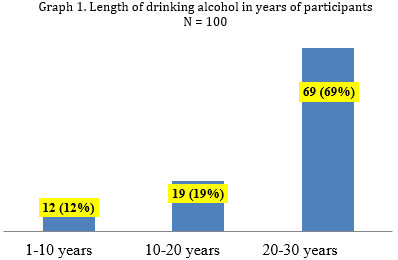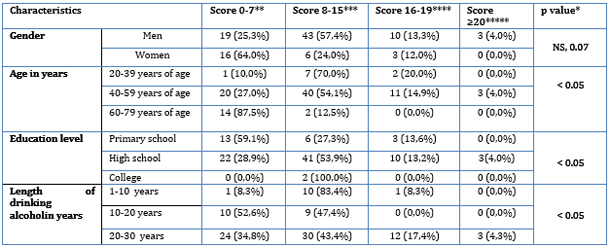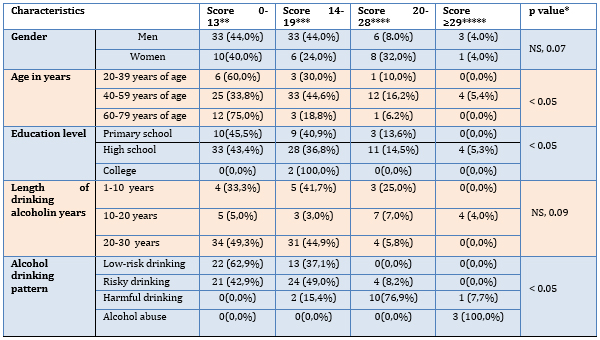|
||||||||||||||||||||||||||||||||||||
| [
Contents
] [ INDEX ]
|
||||||||||||||||||||||||||||||||||||
| UDK 616.895.4-056.83 613.81 COBISS.SR-ID 16466185 |
Page 6 |
|||||||||||||||||||||||||||||||||||
|
Original paper Factors affecting development of depression in people who drink alcohol Jandric-Kocic Marijana HEALTH CENTER KRUPA NA UNI, REPUBLIC OF SRPSKA |
||||||||||||||||||||||||||||||||||||
|
|
||||||||||||||||||||||||||||||||||||
| Download in pdf format | SUMMARY:
Introduction: About 90% of people consume alcohol at some point in
their lives. Alcohol abuse occurs in 5-10% of these, while addiction
develops in 10% of men and 3-5% of women. Alcohol consumption can
induce depression or contribute to its severity. Objective: The
study aimed to examine the existence of statistically significant
associations between patterns of drinking alcohol, duration of
alcohol use, and sociodemographic factors with depression present in
persons consuming alcohol. Materials and Methods: The
cross-sectional study included 100 individuals, 25.0% women and
75.0% men, with an average of 53.0 ± 1.5 years consuming alcohol
over a period of eight months, from 01.10.2018. to 01.06.2019. at
the Krupa Health Center on the Una. In addition to the additional
tests, they also used the Audit of Identity Disorders Identification
Disorders (AUDIT) test and Beck's Depression Inventory (BDI).
Results: Participants with harmful alcohol drinking had a
statistically significant presence of depression compared to
subjects with other alcohol drinking patterns (p <0.05). There was
no statistically significant difference in the presence of
depression in relation to the duration of alcohol use (p = 0.09) and
the gender of subjects consuming alcohol (p = 0.07). Participants
aged 40-59 with high school diploma who consumed alcohol had
statistically significant presence of depression in relation to
other good groups and the level of education (p <0.05).Conclusion:
The study confirmed the significant role of harmful alcohol
drinking, the age and level of education in the development of
depression in persons consuming alcohol. Keywords: alcohol, abuse, mental health, depression |
|||||||||||||||||||||||||||||||||||
| INTRODUCTION Alcohol consumption is a socially acceptable activity in Western Europe. In our region it is favoured to the level of an obligatory ritual in many social situations. It is estimated that about 90% of people consume alcohol at some point in their life. Alcohol abuse occurs in 5-10%, while addiction develops in 10% of men and 3-5% of women [1,2,3]. Alcohol consumption can induce depression or contribute to its severity through several potential mechanisms. Moderate doses of alcohol reduce the concentration of tryptophan, homovalinic acid, γ-amino butyric acid, N-methyl-D aspartate endogenous opioids. Its use has a negative impact on cognitive functions, contributes to feelings of inferiority, guilt and hopelessness, disrupts interpersonal relationships, and induces delinquency [4]. A primary depressive disorder in persons who consume alcohol precedes alcohol intoxication and/or alcohol withdrawal or occurs within four weeks after alcohol consumption has stopped. Between these two periods, there can only be alcohol-induced depression that is considered a consequence of abstinence syndrome and goes away spontaneously. Depression that persists after four weeks of abstinence is considered secondary [5]. OBJECTIVE The aim of the study was to investigate: -1): the existence of statistically significant correlation of alcohol drinking pattern with the presence of depression in alcohol drinkers, -2): the existence of statistically significant association of the duration of alcohol use with the presence of depression in alcohol drinkers,-3) : the existence of a statistically significant association of sociodemographic factors with the presence of depression in alcohol drinkers. MATERIAL AND METHODS The cross-sectional study included 100 people who consumed alcohol for a period of eight months from 01.10.2018. do 01.06.2019. at the Krupa Health Center on the Una. The criteria for inclusion of the respondents in the study were: age between 20 and 79 years, completed primary school and anamnestic data on alcohol consumption for at least twelve months. The study excluded persons: over the age of 79 and under 20 with alcohol consumption of less than twelve months, as well as all persons with malignant and advanced chronic diseases (chronic renal failure, heart decompensating, liver failure). Data were collected through the use of general and specific questionnaires. The general questionnaire collected sociodemographic data (gender and age, level of education). Beck's Depression Inventory (BDI) is used as an indicator of the existence and intensity of depressive symptoms that are in accordance with the current Diagnostic and Statistical Manual of Mental Disorders (DSM). Today, another revised version recommended by the American Psychiatric Association (APA) is in use. It consists of 21 statements (each statement is a list of four statements ranked according to the intensity of a particular symptom of depression) that we score from 0 to 3. A total score of 0 to 13 excludes the existence of depression. The results in the interval of 14 to 19 speak in favour of mild depression. There is moderate depression in the score 20-28. Severe depression is present in patients who have a score of 29-63 [6,7]. The Alcohol Use Disorders Identification Test (AUDIT) is intended for the early identification of risky and harmful drinking as well as alcohol dependence, developed and recommended by the World Health Organization (WHO). The test consists of three questions in the area of risky alcohol use (frequency of drinking, typical amount, frequency of heavy drinking), three questions covering the symptoms of addiction (diminished control over drinking, increased drinking desire, morning drinking) and four questions in the area of harmful alcohol use (guilt after drinking, amnesia, alcohol-related injuries, environmental concerns), which we score 0-4. Score 0-7 is in favour of low-risk drinking. The result in the interval 8-15 corresponds to risky drinking. Harmful drinking is present in subjects with a score of 16-19. The score 20-40 reveals alcohol abuse [1,8]. Descriptive statistical methods were used to analyse the data: abundance frequency distribution, arithmetic mean, standard deviation, and percentages. To determine statistical significance the χ2-independence test was used. The significance level was set at 95% confidence interval. The results are presented textually, in tabular form and graphically, and the complete work is processed in Microsoft Word for Windows text processor. RESULTS The study included 100 patients. Among them, 25.0% were women and 75.0% were men. The majority of respondents who consume alcohol (58%) are 40-59 years of age. The average age of the study population was 53.0 ± 1.5 years. Women were statistically significantly older than men. 22% of respondents had completed primary school, 2% had college education. High school graduation rate was 76%. Table 1. Distribution of alcohol
drinkers by gender, age and education level Most participants (69%) consumed alcohol for 20-30 years. The second most frequent were respondents (19%) who consumed alcohol for a period of 10-20 years. The smallest number of study participants (12%) consumed alcohol for 1-10 years.
The highest number of respondents (49%) identified risky drinking. Low-risk drinking was verified in 35% of respondents, harmful drinking in 13%. The smallest number of respondents reported alcohol abuse (3%). Male respondents, 40-59 year old with high school diploma as well as alcohol drinkers for 20-30 years had a statistically significantly higher percentage of risky and harmful drinking as well as alcohol dependence. Table 2. Distribution of gender, age and education
level of alcohol drinkers by AUDIT (alcohol use disorders
identification test) Depression was reported in 42 (46.0%) men and 15 (60.0%) women. 6
(8.0%) men and 8 (32.0%) women had moderate depression. Severe
depressive disorders were verified in 3 (4.0%) men and 1 (4.0%)
woman. The study could not detect a statistically significant
difference in the presence of depression in relation to the gender
of alcohol-consuming subjects (p = 0.07). Depression was present in
4 (40.0%) subjects aged 20-39 years, 49 (66.2%) subjects aged 40-59
years and 4 (25.0%) subjects aged 60-79 years. Moderate depressive
disorders were experienced by 1 (10.0%) subject aged 20-39 years, 12
(16.2%) subjects aged 40-59 years and 1 (6.2%) subject aged 60-79
years. Severe depressive disorders were found in 4 (5.4%) persons
aged 40-59 years. Presence of depression in subjects 40-59 years of
age who consumed alcohol was statistically significantly more
frequent than in subjects of other age groups (p <0.05). Depression
problems were experienced by 12 (44.5%) respondents with completed
primary education and 43 (46.6%) respondents with completed
secondary education. Moderate depression was found in 3 (13.6%)
subjects with completed primary education and 11 (14.5%) subjects
with completed secondary education. Severe depressive disorders were
verified in 4 (5.3%) of high school graduates. Participants in the
study who consumed alcohol with high school diploma had presence of
depression statistically significantly more frequent compared to
respondents with other levels of education (p <0.05). Depression was
found in 8 (66.7%) subjects who consumed alcohol for 1-10 years, 14
(95.0%) subjects who consumed alcohol for 10-20 years, and 35
(50.7%) subjects who consumed alcohol for 20-30 years. Moderate
depressive disorders were experienced by 3 (25.0%) subjects who
consumed alcohol for 1-10 years, 7 (7.0%) subjects who consumed
alcohol for 10-20 years, and 4 (5.8%) subjects who consumed alcohol
for 20- 30 years. Severe depressive disorders were verified in 4
(4.0%) subjects who consumed alcohol for 10-20 years. There was no
statistically significant difference in the presence of depression
in alcohol drinkers with respect to the duration of alcohol
consumption (p = 0.09). Table 3. Distribution of sociodemographic
characteristics, length of drinking alcohol and drinking patterns of
alcohol drinkers by BDI (Beck's Depression Inventory) DISCUSSION
|
||||||||||||||||||||||||||||||||||||
|
|
||||||||||||||||||||||||||||||||||||
|
Corresponding Address: Marijana C. Jandrić-Kočič, Dom zdravlja, Krupa na Uni E-mail: marijanajandrickocic@gmail.com |
Paper received: 15.1.2020 Paper Internet issues: 30.6.2020 |
|||||||||||||||||||||||||||||||||||
| [
Contents
] [ INDEX ]
|
||||||||||||||||||||||||||||||||||||
|
||||||||||||||||||||||||||||||||||||




